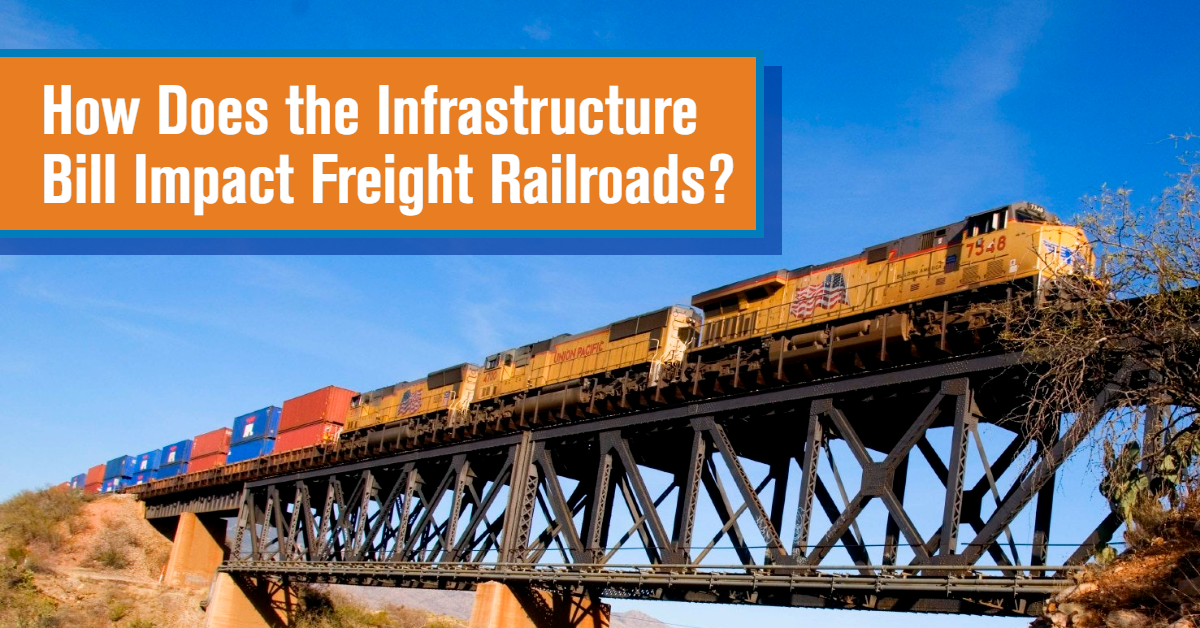Every four years, the American Society of Civil Engineers (ASCE) releases a Report Card for America’s Infrastructure, grading a number of infrastructure categories then averaging them into an overall score for the country’s infrastructure. According to the 2021 Report Card, America’s infrastructure scores a C- grade overall. That means we’re going to need to do some extra credit to get that grade up.
Enter the $1.2 trillion Bipartisan Infrastructure Law, which provides funding for the types of work that must be done for our infrastructure to earn a passing grade. Here’s how the funds are set to be allocated, the impact it will have on freight rail, and how taxpayers benefit as a result.
What Types of Projects Does the Bipartisan Infrastructure Law Fund?
The Bipartisan Infrastructure Law bolsters budgets for things like roadway, bridge, transit and rail projects, upgrading broadband infrastructure to make the Internet accessible to all, addressing the climate crisis, promoting the use of and building infrastructure for electric vehicles, and improving power and water systems.
Of the $1.2 trillion, $66 billion is allocated to rail; however, the vast majority of those dollars will go to passenger rail projects. That’s because freight railroads pay to maintain and expand their own infrastructure. On average, freight railroads invest approximately $25 billion a year to build and maintain their own infrastructure.
Freight rail infrastructure is in better shape thanks to the ongoing investments railroads make to maintain the network. The ASCE gives railroads a B grade, the highest grade in its 2021 Infrastructure Report Card. However, the ASCE’s rail category rates freight and passenger rail together, so it’s safe to say that if freight rail stood on its own, it would likely merit a higher grade.
How Will the Bipartisan Infrastructure Law Benefit Freight Railroads?
Even though Amtrak and passenger agency partners will be the primary beneficiary of the funds allocated to passenger and freight rail, that doesn't mean railroads, their customers, and the communities where they operate won't see benefits from the infrastructure bill. The following are just a few examples:
- The infrastructure bill devotes an average of $5.55 billion per year over five years to infrastructure grant programs. These grants will fund multimodal freight projects that will relieve freight bottlenecks, improve connectivity, and fund industrial development projects that can connect freight rail to new markets and more communities. These projects include public-private partnerships in which railroads will contribute private funding proportionate to the benefits they receive as a result.
- The bill creates several programs that fund alternative fuel research and development, and deployment of lower emissions locomotives. This will help railroads in their efforts to address climate change.
- Congress created a $3 billion program dedicated to eliminating or improving the safety of grade crossings (where railroad tracks, roadways and/or pedestrian walkways meet). This will help to improve safety and quality of life for the communities in which freight railroads operate.
- Funding for the Consolidated Rail Infrastructure and Safety Improvement grant program (CRISI) will get $1 billion per year through 2026, up from $362 million in fiscal year 2021. These grants support things like regional and short line track and infrastructure projects such as major track upgrades and bridge replacements.
How Does Investing in Freight Rail Benefit the Community?
- Railroads help reduce congestion on U.S. highways. Because rail cars can hold three to four truckloads of freight, just one train can take more than 300 trucks off the road. When multiplied by a year’s worth of shipments across North America, that’s a lot of trucks. The result is reduced congestion on already overcrowded highways, less wear and tear on bridges and roadways, and a lessened burden on the taxpayers who pay to fix the damage.
- Moving freight by rail saves taxpayer dollars. Because freight railroads operate on infrastructure they own, build, maintain and pay for themselves, taxpayers save billions of dollars each year they would otherwise have to pay to maintain roadways if those shipments moved by truck.
- Railroad investments support economic growth. Between 1980 and 2020, America’s freight railroads spent nearly $740 billion on the country’s 140,000-mile rail network. Those private investments support 1.1 million jobs, generating almost $220 billion in economic activity.
- Railroads are the most environmentally responsible way to ship freight by land. On average, railroads are three to four times more fuel efficient than trucks on a ton-mile basis. That’s because railroads can move one ton of freight more than 480 miles on a single gallon of fuel, generating a carbon footprint up to 75% less than trucks. In fact, if 10% of the freight shipped by the largest trucks moved by rail instead, it would cut greenhouse gas emissions by more than 17 million tons each year — the equivalent of removing 3.35 million cars from our highways or planting 260 million trees.
Learn More
Shipping freight by rail benefits taxpayers, communities and the environment — but it also benefits shippers of both raw goods and finished products. To learn more about how rail can benefit your supply chain, answer a few questions and an expert will be in touch.
To learn more about the impacts of the Infrastructure Law on industrial markets, watch our webinar featuring federal infrastructure funding expert Alex Etchen.
Related Articles
- How Will the Infrastructure Law Impact Industrial Markets?
- The Impact of America’s Failing Infrastructure on Supply Chains
- America’s “Water Highway” Is Aging — Are You Prepared for the Closures Ahead?
- Freight Shipping and Its Impact on Climate Change
- Rail: An Environmentally Responsible Way to Ship
- The Rail Industry Is Saving Millions of Gallons of Fuel a Year – And They’re Using “Cruise Control” to Do It
- Quiz: Is Rail the Right Fit for Your Shipments?
- Rail 101 FAQs
- Transportation Modes Revealed: A Comprehensive Look









